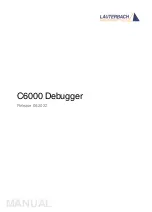
7
Maintenance
Preventive maintenance is the key to the long life of any mechanical device.
Careful and systematic inspection of all BeltVeyor equipment will result in maximum, trouble-free
service.
BELT REPLACEMENT ………
To replace the belt, cut it into and hand rotate the drive pulley until belt has been removed. Install
appropriate belt as outlined in assembly instructions.
Refer to page 12.
DRIVE ASSEMBLY TAKE-UP ………
After extended use, the conveyor belt may stretch to the point that there is not sufficient take-up
in the drive assembly to tighten it. Obtain additional take-up by cutting a 6" to 8" section from belt.
A new splice lacing may be ordered from your CrustBuster/Speed King distributor or the factory.
PERIODIC CLEAN-OUT ………
Due to the characteristics of certain materials, residue sometimes collects between the conveyor
belt and the tube. Check the unit periodically for any material build up in this area. If residue
appears excessive, remove the conveyor belt and thoroughly wash the belt and tube. Allow belt
and tube to dry before reinstalling the belt.
When conveyor is not being used, secure belt to the tube to prevent belt from flopping in the wind,
possibly breaking return idlers or ripping belt.
LUBRICATION ………
All bearings which are fitted with grease zerks should be lubricated at the conclusion of each
operating day. Before greasing bearings, make certain the zerks are free of dirt, otherwise this will
be passed into the bearing race. If unit will be out of service for a period of time, purge bearings.
Electric motor should be oiled in accordance with the manufacturers recommendations.
Roller chains should be oiled with a light weight oil at the conclusion of each days' operation.
Keep PTO shaft and tube well greased so they move freely.
CONVEYOR BELT TRAINING PROCEDURE ………
A conveyor belt correctly installed and trained will run straight and true. The belt must run centered
on all terminal pulleys, take-up pulleys, and return idlers throughout the entire belt length.
Incorrect installation and training can result in severe edge damage, material spillage, material
leakage through the skirt rubber at the loading point, and excessive power demands. Material
spillage is the usual reason for belt carcass ruptures and pulley cover gouging and stripping, while
leakage at the skirt rubber results in excessive conveyor cover wear under the skirts.
ALIGNMENT ………
All rotating parts -head pulleys, tail pulleys, take-up pulleys, and return idlers- must be at a 90
degree angle to the direction of belt travel, must be level, and the midpoint of each centered on a
line when properly aligned.
Alignment is checked by running a tight wire from center of the head pulley to center of tail pulley.
Center all other rotating parts on the wire.
Level all rotating parts. If a part is not level, the belt will run to the lower side.
Check that all parts are at a 90° or right angle to the wire. If a part is not at 90° to the center line,
the belt will run to the side that if first contacts.
BELT SPLICING ………
A conveyor belt must not run out at the splice area. Runout will occur if the splice is not in
alignment or correctly made.
SKIRTING & BRUSH………
Maintain skirtboards and brush to prevent spillage of grain.
Summary of Contents for BeltVeyor Crescent
Page 1: ...BeltVeyor 16 Honeycomb Crescent Owner s Manual 04149100 2012 ...
Page 12: ...10 Dimensions ...
Page 13: ...11 Winch Wrap Diagram 20 30 Cable Mount Diagram 40 50 70 ...
Page 19: ...17 BeltVeyor Repair Parts Tubes 10 Half Band 10319210 ...
Page 22: ...20 20 BeltVeyor Electric Head Tail and Pan ...
Page 24: ...22 20 BeltVeyor Electric Conveyor Parts ...
Page 26: ...24 20 BeltVeyor Electric Drive and Undercarriage ...
Page 28: ...26 20 BeltVeyor Hydraulic Head Tail and Pan ...
Page 30: ...28 20 BeltVeyor Hydraulic Conveyor Parts ...
Page 32: ...30 20 BeltVeyor Hydraulic Drive and Undercarriage ...
Page 34: ...32 ...
Page 36: ...34 30 BeltVeyor Electric Head Tail and Pan ...
Page 38: ...36 30 BeltVeyor Electric Conveyor Parts ...
Page 40: ...38 30 BeltVeyor Electric Drive and Undercarriage ...
Page 42: ...40 30 BeltVeyor Hydraulic Head Tail and Pan ...
Page 44: ...42 30 BeltVeyor Hydraulic Conveyor Parts ...
Page 46: ...44 30 BeltVeyor Hydraulic Drive and Undercarriage ...
Page 48: ...46 ...










































